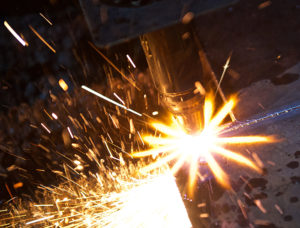Robotic Welding is the Key to Producing Precision Parts
Automotive OEMs and after-market manufacturers turn to steel suppliers with robotic welding capabilities.
Robotic Welding and the Automotive Industry
Robotic welding is not new to the automotive industry, but it is gaining traction in the production of precision parts for  both new and older vehicles. Original Equipment Manufacturers (OEMs) are under pressure to produce new, higher tech vehicles (i.e. autonomous and electric), and after-market manufacturers must follow suit. As this pressure to produce increases, demand for vehicle component clusters among Tier 1 and 2 steel suppliers also increases.
both new and older vehicles. Original Equipment Manufacturers (OEMs) are under pressure to produce new, higher tech vehicles (i.e. autonomous and electric), and after-market manufacturers must follow suit. As this pressure to produce increases, demand for vehicle component clusters among Tier 1 and 2 steel suppliers also increases.
“Robotic welding is expected to grow at a Compound Annual Growth Rate (CAGR) of 8.91% from 2018-2023 to reach a market size of $5.96 billion by 2023. The automotive and transportation segment of the robotic welding market by the end user is expected to grow at the highest CAGR from 2018 to 2023…due to increasing vehicle demand in emerging economies and increasing adoption of electric vehicles throughout the globe.” (Reported by Reportlinker)
Benefits of Robotic Welding
The American Welding Society predicts a shortage of over 375,000 skilled welding professionals by 2023. Robotic welding is an important way for steel suppliers to address the shortage and provide even higher quality products to their customers.
Some of the benefits of robotic welding include:
- Increased welding capacity and scalability for repeatable parts
- Consistent quality
- Predictable costs to produce parts
- Programming can be changed to meet the changing specifications and expectations of customers
Outsourcing Robotic Welding
The automotive industry is experiencing tremendous disruption in innovation and production. Having the ability to outsource the fabrication of specific components to reliable steel suppliers who can precisely manufacture is a pivotal way to meet the rapidly changing demands of the market. From crank shafts to fuel components to support brackets or more specialized parts required by OEMs, robotic welding can be an optimal way to produce these components in high volume.
Some of the reasons to outsource robotic welding include:
- Cost Reduction: Securing a strong partnership with a qualified steel supplier who can produce high volumes of robotic welds is key to reducing costs. By eliminating overhead (i.e. equipment, maintenance, management, etc.), automotive parts manufacturers avoid some of the hidden costs of fabricating steel parts in-house.
- Quality: The quality of the finished parts produced should be as good or better than the original manufacturer itself. A reliable steel supplier will have the certified robotics staff and the experience necessary to manage the project and ensure quality control.
- Capacity: Because of the irregularity in demand and production, automotive manufacturers frequently must outsource the fabrication of parts. Outsourcing robotic welding projects to a trusted steel fabricating partner is an ideal way to meet production needs and minimize stress on manufacturing.
Westfield Steel Robotic Welding
Founded in 1977, Westfield Steel has deep midwestern roots fabricating and distributing steel for businesses throughout Indiana, Ohio, Illinois, Missouri, Kentucky and Tennessee. Large-scale production welding orders are completed with speed and precision by our Fanuc Arcmate 100i GMAW Welding Robots. We can recreate thousands of assemblies in short order. We offer a 360-degree weld service capability that can meet large order volumes efficiently.
“Much like our OEM partners, our industry is under fierce pressures. However, with pressure comes opportunity, and that pressure is part of what drives our desire for continuous improvements at Westfield Steel. Our Robotic Welding capabilities allow us to deliver the high-precision required by Automotive OEMs, while offering our services at a competitive price.” Fritz Prine, President, Westfield Steel.
Back